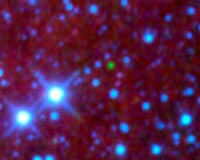 |
Boston MA (SPX) Nov 17, 2010 Sometimes when you're looking for one thing, you find something completely different and unexpected. In the scientific endeavor, such serendipity can lead to new discoveries. Today, researchers who found the first hypervelocity stars escaping the Milky Way announced that their search also turned up a dozen double-star systems. Half of those are merging and might explode as supernovae in the astronomically near future. All of the newfound binary stars consist of two white dwarfs. A white dwarf is the hot, dead core left over when a sun-like star gently puffs off its outer layers as it dies. A white dwarf is incredibly dense, packing as much as a sun's worth of material into a sphere the size of Earth. A teaspoon of it would weigh more than a ton. "These are weird systems - objects the size of the Earth orbiting each other at a distance less than the radius of the Sun," said Smithsonian astronomer Warren Brown, lead author of the two papers reporting the find. The white dwarfs found in this survey are lightweight among white dwarfs, holding only about one-fifth as much mass as the Sun. They are made almost entirely of helium, unlike normal white dwarfs made of carbon and oxygen. "These white dwarfs have gone through a dramatic weight loss program," said Carlos Allende Prieto, an astronomer at the Instituto de Astrofisica de Canarias in Spain and a co-author of the study. "These stars are in such close orbits that tidal forces, like those swaying the oceans on Earth, led to huge mass losses." Remarkably, because they whirl around so close to each other, the white dwarfs stir the space-time continuum, creating expanding ripples known as gravitational waves. Those waves carry away orbital energy, causing the stars to spiral closer together. Half of the systems are expected to merge eventually. The tightest binary, orbiting once every hour, will merge in about 100 million years. "We have tripled the number of known, merging white-dwarf systems," said Smithsonian astronomer and co-author Mukremin Kilic. "Now, we can begin to understand how these systems form and what they may become in the near future." When two white dwarfs merge, their combined mass can exceed a tipping point, causing them to detonate and explode as a Type Ia supernova. Brown and his colleagues suggest that the merging binaries they have discovered might be one source of underluminous supernovae - a rare type of supernova explosion 100 times fainter than a normal Type Ia supernova, which ejects only one-fifth as much matter. "The rate at which our white dwarfs are merging is the same as the rate of underluminous supernovae - about one every 2,000 years," explained Brown. "While we can't know for sure whether our merging white dwarfs will explode as underluminous supernovae, the fact that the rates are the same is highly suggestive."
Share This Article With Planet Earth
Related Links Harvard-Smithsonian Center for Astrophysics Stellar Chemistry, The Universe And All Within It
 Cool Star Is A Gem Of A Find
Cool Star Is A Gem Of A FindWashington DC (SPX) Nov 10, 2010 NASA's Wide-field Infrared Survey Explorer, or WISE, has eyed its first cool brown dwarf: a tiny, ultra-cold star floating all alone in space. WISE is scanning the whole sky in infrared light, picking up the glow of not just brown dwarfs but also asteroids, stars and galaxies. It has sent millions of images down to Earth, in which infrared light of different wavelengths is color-coded in t ... read more |
|
| The content herein, unless otherwise known to be public domain, are Copyright 1995-2010 - SpaceDaily. AFP and UPI Wire Stories are copyright Agence France-Presse and United Press International. ESA Portal Reports are copyright European Space Agency. All NASA sourced material is public domain. Additional copyrights may apply in whole or part to other bona fide parties. Advertising does not imply endorsement,agreement or approval of any opinions, statements or information provided by SpaceDaily on any Web page published or hosted by SpaceDaily. Privacy Statement |